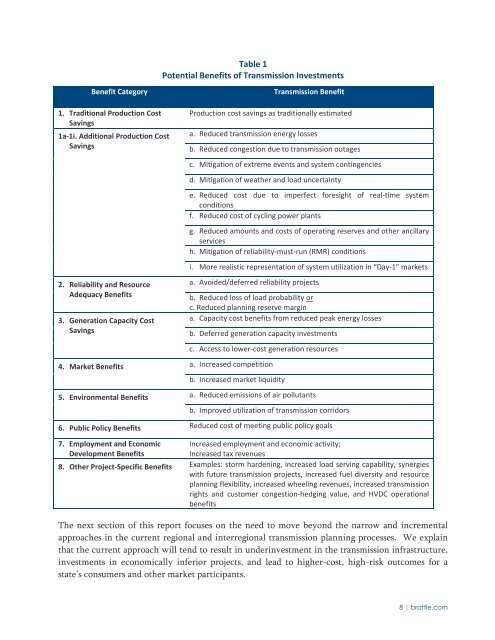THE BRATTLE GROUP
pvrbYG
pvrbYG
You also want an ePaper? Increase the reach of your titles
YUMPU automatically turns print PDFs into web optimized ePapers that Google loves.
Table 1<br />
Potential Benefits of Transmission Investments<br />
Benefit Category<br />
Transmission Benefit<br />
1. Traditional Production Cost<br />
Savings<br />
1a‐1i. Additional Production Cost<br />
Savings<br />
2. Reliability and Resource<br />
Adequacy Benefits<br />
3. Generation Capacity Cost<br />
Savings<br />
Production cost savings as traditionally estimated<br />
a. Reduced transmission energy losses<br />
b. Reduced congestion due to transmission outages<br />
c. Mitigation of extreme events and system contingencies<br />
d. Mitigation of weather and load uncertainty<br />
e. Reduced cost due to imperfect foresight of real‐time system<br />
conditions<br />
f. Reduced cost of cycling power plants<br />
g. Reduced amounts and costs of operating reserves and other ancillary<br />
services<br />
h. Mitigation of reliability‐must‐run (RMR) conditions<br />
i. More realistic representation of system utilization in “Day‐1” markets<br />
a. Avoided/deferred reliability projects<br />
b. Reduced loss of load probability or<br />
c. Reduced planning reserve margin<br />
a. Capacity cost benefits from reduced peak energy losses<br />
b. Deferred generation capacity investments<br />
c. Access to lower‐cost generation resources<br />
4. Market Benefits a. Increased competition<br />
b. Increased market liquidity<br />
5. Environmental Benefits a. Reduced emissions of air pollutants<br />
b. Improved utilization of transmission corridors<br />
6. Public Policy Benefits Reduced cost of meeting public policy goals<br />
7. Employment and Economic<br />
Development Benefits<br />
Increased employment and economic activity;<br />
Increased tax revenues<br />
8. Other Project‐Specific Benefits Examples: storm hardening, increased load serving capability, synergies<br />
with future transmission projects, increased fuel diversity and resource<br />
planning flexibility, increased wheeling revenues, increased transmission<br />
rights and customer congestion‐hedging value, and HVDC operational<br />
benefits<br />
The next section of this report focuses on the need to move beyond the narrow and incremental<br />
approaches in the current regional and interregional transmission planning processes. We explain<br />
that the current approach will tend to result in underinvestment in the transmission infrastructure,<br />
investments in economically inferior projects, and lead to higher-cost, high-risk outcomes for a<br />
state’s consumers and other market participants.<br />
8 | brattle.com


